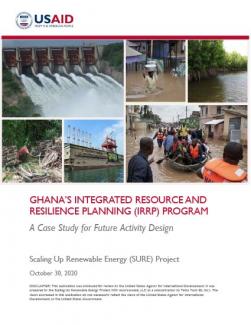Ghana's Integrated Resource and Resilience Planning Program
Scaling Up Renewable Energy (SURE)
Case study –
The Integrated Resource and Resilience Planning Program delivered a coordinated roadmap for future power sector development that could ensure low-cost, least-regrets resource capacity available at the right time and place.
A Case Study for Future Activity Design
As prices for clean energy and storage technologies continue to fall and nations race to cut emissions under the Paris Agreement, power utilities must be able to integrate higher shares of renewable energy strategically to meet growing energy demand and increase the number of people with access to electricity. Poor resource planning can cause energy shortages and service interruptions (e.g., load shedding), lead to energy surpluses that raise electricity prices due to supply and demand imbalance, and increase vulnerability to fossil fuel price fluctuations and emissions.
Improving the Integrated Resource Plan
The Integrated Resource and Resilience Planning process produces data and other information to support competitive procurement, including auctions. The IRRP process and the procurement process are mutually beneficial, resulting in a power system master plan that identifies medium- and long-term resource needs, delineates the optimal way to meet those needs, and provides a benchmark for measuring the cost and rate impacts of developing such resources. The master plan can also support the development of a request for proposals (RFP) for procuring a variety of power sector assets. It provides key information that potential bidders can use to support the assumptions underlying their bids.
The IRRP adds to the Integrated Resource Plan framework by moving from a least-cost paradigm to a least-regrets paradigm, applying a systematic framework that assesses important policy objectives. A least-regrets decision-making framework explicitly considers risks and uncertainties to identify an investment strategy that will be robust across a range of possible futures (e.g., demand and economic outcomes; drought; fuel disruptions) and seeks to minimize the most severe combination of regrets. The higher cost of a least-regrets plan, as compared to a least-cost plan, represents an insurance policy that protects the nation against the worst outcomes.
Ghana’s IRRP Process and Integrated Power System Master Plan
Ghana’s IRRP process resulted in delivery of the Ghana Integrated Power System Master Plan (IPSMP). This policy document provides a rational basis for decision-making and implementation of energy projects identified in the least-regrets portfolio strategy and is rooted in sound technical analyses that consider various risks, uncertainties, and constraints in the country. To ensure that the IRRP process delivers an IPSMP that meets the needs of the sector governance structure and can be implemented with broad support, it is critical to clearly define the vision and priorities of the energy sector’s key stakeholders.
USAID and the IRRP program team partnered with Ghana’s Ministry of Energy to define the specific objectives for the Ghana IPSMP:
- Achieve cost-competitiveness in power generation and delivery;
- Reliably meet local demand and exports in a timely manner;
- Increase the resilience of the power system;
- Ensure positive economic impacts through job creation and gross domestic product growth;
- Meet Ghana’s local environmental and climate change commitments;
- Promote and implement sustained energy efficiency and demand-side management programs; and
- Support secondary objectives beyond current universal access goals
(e.g., productive uses of electricity, household-level connection, mini-grids).
Recommendations for Future Activity Design
The Ghana IRRP program serves as a leading reference case for USAID staff and implementing partners working to design, tailor, and institutionalize power sector planning methods across utilities and government agencies.
During the development and implementation of the Ghana program, the IRRP team identified several lessons that contributed to the program’s success. Establishing a solid foundation in these areas should be a focus for any future IRRP activity design or support. These lessons are distilled into four key recommendations below:
- Establish early government ownership;
- Establish a clear pathway to stakeholder collaboration;
- Establish a process for data collection and improvement; and
- Tailor the IRRP process to the unique country context.

